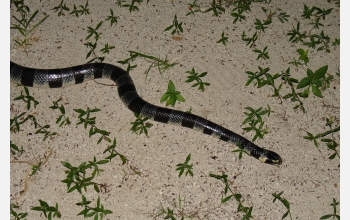Multimedia Gallery
Yellow-lipped sea krait (Laticauda colubrina)
A yellow-lipped sea krait (Laticauda colubrina) on the shore near Turtle Island, Fiji. This family of sea snakes are quite common around islands and reefs in the Pacific Ocean. Altogether, there are five species of sea kraits, four of which are marine.
The yellow-lipped sea krait is a member of the Laticaudid family and is amphibious. Sea kraits are the only group of sea snakes that are oviparous (egg laying) and must return to land to breed and lay their eggs. Laticaudid also digest their food and shed their skins on land. These traits differ from the main family of "true" sea snakes--Hydrophiidae--which have adapted so that they never have to leave water, not even to bear their young which are born live at sea.
The yellow-lipped are large, with males reaching up to 100 cm; females up to 150 cm. They are strongly banded and have highly toxic venom, but are very placid and unlikely to bite unless provoked.
The Laticauda colubrina are not endangered, but their populations have dwindled to the point of extinction on some Japanese and Philippine islands due to over-harvesting for their meat and skins.
In response to the problem, a research team decided to experiment with relocation of yellow-lips, taking snakes from other islands and releasing them where the populations had declined.*
The team chose two adjacent islands for their study, 5.3 km. apart--Mabualau (uninhabited) and Toberua (a resort island). From August to December 1998 and 1999, snakes on Mabualua were captured by hand, sexed, weighed and marked individually by clipping scales. The animals were released near the team's campsite on the island of Mabualau. On the island of Toberua, staff at the local resort captured snakes and brought them across the water to Mabualau. The researchers processed the Toberua snakes in the same manner as the others and released them near the campsite on Mabualau as well.
A total of 674 snakes from Mabualau were captured and marked and 328 from Toberua. After reviewing all their data, the team was amazed to discover extreme homing instincts in yellow-lipped sea kraits and rapid homing of snakes displaced from Toberua to Mabualau. In fact snakes originally captured on Mabualau were never recaptured on Toberua and in turn, Toberua snakes were never recaptured on Mabualau. Not only were the animals loyal to their home (island) if undisturbed, they would rapidly return if displaced for any reason. Twenty-three individuals who were recaptured multiple times and were found to have returned home very quickly, within 30.7 days.
Whether or not this strong homing instinct exists in all members of the Laticaudidae family is unknown, but a similar, shorter study on another island in the Pacific showed similar results, suggesting that there is a good possibility that it does.
[*Full results of this study appeared in Conservation Biology, Vol. 16, No. 5, October 2002.]
Credit: David Flagg, National Science Foundation
Images and other media in the National Science Foundation Multimedia Gallery are available for use in print and electronic material by NSF employees, members of the media, university staff, teachers and the general public. All media in the gallery are intended for personal, educational and nonprofit/non-commercial use only.
Images credited to the National Science Foundation, a federal agency, are in the public domain. The images were created by employees of the United States Government as part of their official duties or prepared by contractors as "works for hire" for NSF. You may freely use NSF-credited images and, at your discretion, credit NSF with a "Courtesy: National Science Foundation" notation.
Additional information about general usage can be found in Conditions.
Also Available:
Download the high-resolution JPG version of the image. (3.3 MB)
Use your mouse to right-click (Mac users may need to Ctrl-click) the link above and choose the option that will save the file or target to your computer.

